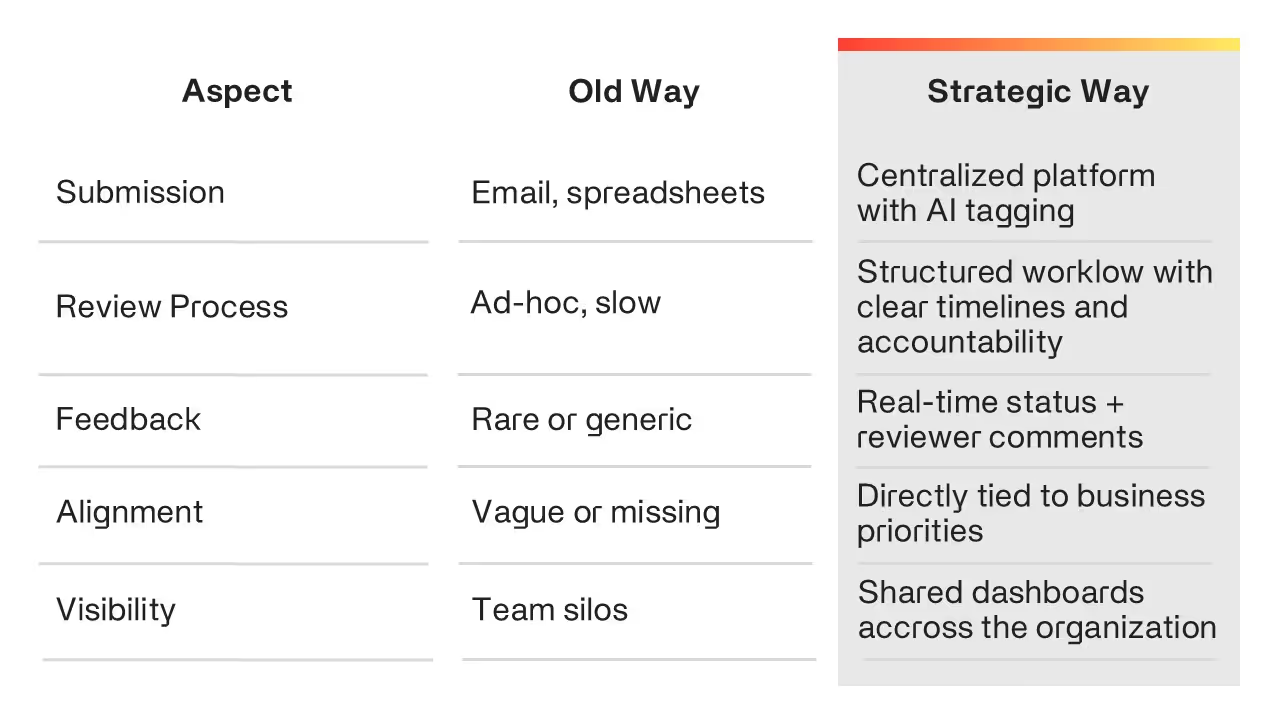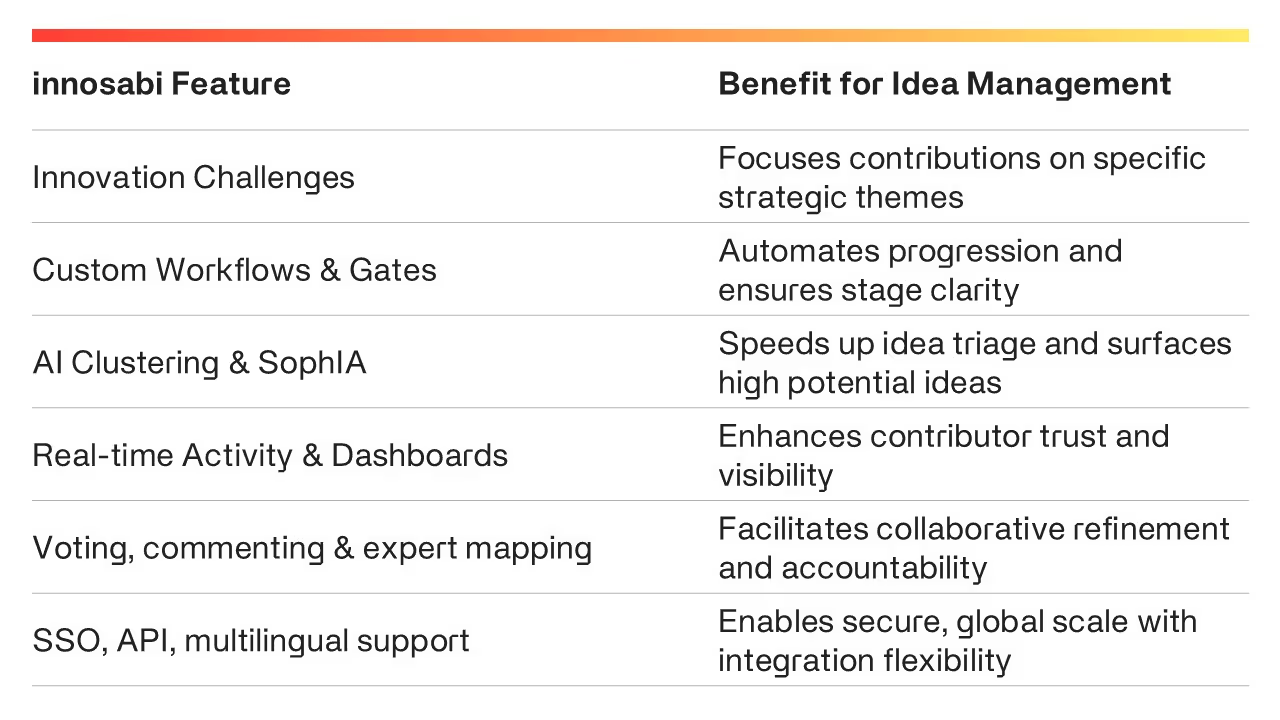Why Most Idea Management Systems Fail (and What to Do Instead)




Most idea management systems fail because they focus on collecting as many ideas as possible, without the structure needed to sort, evaluate, and act on them.
The outcome? Cluttered pipelines, disengaged teams, and lost opportunities.
Many idea management systems operate on the assumption that more ideas equate to more innovation. But in practice, volume without structure simply creates noise. When submissions flood in without a clear framework for evaluation, teams become overwhelmed, meaningful opportunities get buried, and the system quickly loses credibility.
“Research also shows that the main cause of failure of most idea management systems is the slow or lack of response to the submitted ideas’’ (source)
Here’s where even well-intentioned programs often lose momentum:
The bottom line? Innovation efforts rarely falter due to a lack of ideas. They struggle because organizations lack the mechanisms to identify, prioritize, and implement the right ones.
In our recent webinar, we took a deep dive into this challenge, exploring how to move from idea overload to real innovation outcomes. We shared practical steps, success stories, and expert tips to help turn inspiration into execution.
If your current system is showing signs of strain, consider optimizing it before replacing it. This is what that can look like in practice:
Don’t launch open submissions without direction. Clearly articulate why you're sourcing ideas, what kinds of ideas are valuable, and how they’ll be evaluated or implemented. The more precise the instructions, the more relevant the contributions will be.
Even the most engaged employees will disengage if their ideas disappear without acknowledgment. Maintain transparency through visible statuses (such as “Pending Review” or “In Evaluation”) to build trust and demonstrate momentum.
Use tags, evaluation criteria, or lightweight scoring mechanisms to help surface ideas with strategic relevance. The goal here isn’t to limit input, but to guide it.
Ad-hoc reviews lead to stagnation. Set a regular cadence for reviewing, updating, and acting on submissions. It doesn’t have to be rigid, but it must be consistent.
To ensure ideas get the attention they deserve, loop in subject-matter experts through defined workflows, so that each idea is evaluated by the right people, based on its type or category.
Loop in decision-makers, budget owners, and operational leads before ideas move into execution. Early alignment reduces friction later and ensures resources are directed toward feasible, high-impact initiatives.
Innovation shouldn’t feel like extra credit. To sustain participation, integrate idea generation and review into existing roles, team rituals, or performance metrics. If it becomes part of how work gets done, it becomes sustainable.
If you’re looking for a more structured approach to managing ideas—from submission to execution, this article offers a clear framework and practical steps to get started.
To build a truly effective innovation program, it's not enough to count submissions. You need to track the metrics that reflect real progress and impact.
Here are the key performance indicators that matter most:
To improve your idea management outcomes, you need the right success metrics. Explore our complete guide on KPIs that drive innovation performance.

With the right infrastructure in place, transforming ideas into tangible results becomes a focused and efficient process. innosabi brings structure to the often chaotic world of ideation, ensuring that ideas are not only collected, but also assessed, refined, and brought to life.
This structured approach is made possible by innosabi’s purpose-built features, including:
Learn more about how innosabi enables strategic ideation at scale, aligned with your business goals. Explore innosabi Idea Management

To transform their traditional employee suggestion program, Munich Airport partnered in 2016 with innosabi to launch a digital idea platform that’s transparent, user-friendly, and collaborative.
What started as a broad open innovation initiative has transformed into a focused, transparent, and rewarding system of internal employee-driven innovation.
Along the way, Munich Airport shifted its focus from quantity to quality, ensuring fewer but stronger ideas, clearer processes, and more successful implementations.
“We are less focused on quantity and much more on quality - and we are actually implementing as many, if not more, ideas than before." - said Johanna Eglseder from Munich Airport.
In 2024, 100 new ideas were submitted, and a total of 205 ideas were completed (implemented, closed, or rejected with feedback).
Read the full case study here.
A structured system that ties ideas to concrete business goals, includes transparent review stages, automates feedback, and enables execution.
Use a dedicated platform to define strategic themes, assign ownership, automate feedback, and score ideas with data.
Look at implementation rate, cycle time, contributor engagement, and strategic alignment. If ideas aren’t moving forward—or the system isn’t tied to business goals—it’s time to reassess.
Look for strategic alignment tools, AI-powered evaluation, configurable workflows, real-time feedback mechanisms, and cross-team collaboration features.
innosabi stands out with advanced AI (SophIA), flexible workflows, and enterprise-ready capabilities. Unlike generic tools, it’s purpose-built for structured innovation—from ideation to execution, with real-time collaboration and expert mapping.
Highly. You can tailor workflows, evaluation criteria, submission fields, reporting formats, and access levels to fit your internal innovation process and business needs.
innosabi supports both. You can run internal idea campaigns or open innovation programs that include external stakeholders such as customers, partners, or startups.

